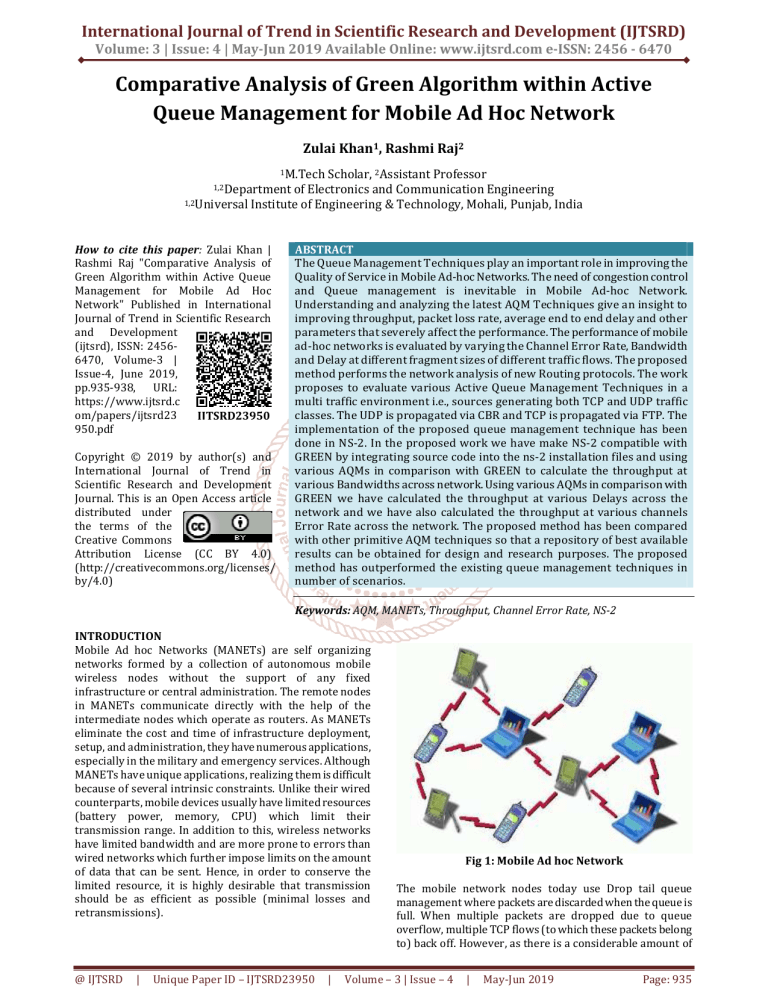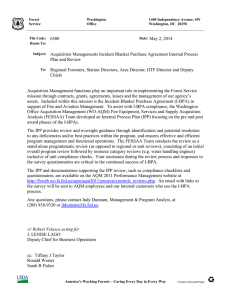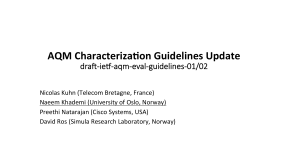
International Journal of Trend in Scientific Research and Development (IJTSRD)
Volume: 3 | Issue: 4 | May-Jun 2019 Available Online: www.ijtsrd.com e-ISSN: 2456 - 6470
Comparative Analysis of Green Algorithm within Active
Queue Management for Mobile Ad Hoc Network
Zulai Khan1, Rashmi Raj2
1M.Tech
Scholar, 2Assistant Professor
1,2Department of Electronics and Communication Engineering
1,2Universal Institute of Engineering & Technology, Mohali, Punjab, India
How to cite this paper: Zulai Khan |
Rashmi Raj "Comparative Analysis of
Green Algorithm within Active Queue
Management for Mobile Ad Hoc
Network" Published in International
Journal of Trend in Scientific Research
and Development
(ijtsrd), ISSN: 24566470, Volume-3 |
Issue-4, June 2019,
pp.935-938, URL:
https://www.ijtsrd.c
om/papers/ijtsrd23
IJTSRD23950
950.pdf
Copyright © 2019 by author(s) and
International Journal of Trend in
Scientific Research and Development
Journal. This is an Open Access article
distributed under
the terms of the
Creative Commons
Attribution License (CC BY 4.0)
(http://creativecommons.org/licenses/
by/4.0)
ABSTRACT
The Queue Management Techniques play an important role in improving the
Quality of Service in Mobile Ad-hoc Networks. The need of congestion control
and Queue management is inevitable in Mobile Ad-hoc Network.
Understanding and analyzing the latest AQM Techniques give an insight to
improving throughput, packet loss rate, average end to end delay and other
parameters that severely affect the performance. The performance of mobile
ad-hoc networks is evaluated by varying the Channel Error Rate, Bandwidth
and Delay at different fragment sizes of different traffic flows. The proposed
method performs the network analysis of new Routing protocols. The work
proposes to evaluate various Active Queue Management Techniques in a
multi traffic environment i.e., sources generating both TCP and UDP traffic
classes. The UDP is propagated via CBR and TCP is propagated via FTP. The
implementation of the proposed queue management technique has been
done in NS-2. In the proposed work we have make NS-2 compatible with
GREEN by integrating source code into the ns-2 installation files and using
various AQMs in comparison with GREEN to calculate the throughput at
various Bandwidths across network. Using various AQMs in comparison with
GREEN we have calculated the throughput at various Delays across the
network and we have also calculated the throughput at various channels
Error Rate across the network. The proposed method has been compared
with other primitive AQM techniques so that a repository of best available
results can be obtained for design and research purposes. The proposed
method has outperformed the existing queue management techniques in
number of scenarios.
Keywords: AQM, MANETs, Throughput, Channel Error Rate, NS-2
INTRODUCTION
Mobile Ad hoc Networks (MANETs) are self organizing
networks formed by a collection of autonomous mobile
wireless nodes without the support of any fixed
infrastructure or central administration. The remote nodes
in MANETs communicate directly with the help of the
intermediate nodes which operate as routers. As MANETs
eliminate the cost and time of infrastructure deployment,
setup, and administration, they have numerous applications,
especially in the military and emergency services. Although
MANETs have unique applications, realizing them is difficult
because of several intrinsic constraints. Unlike their wired
counterparts, mobile devices usually have limited resources
(battery power, memory, CPU) which limit their
transmission range. In addition to this, wireless networks
have limited bandwidth and are more prone to errors than
wired networks which further impose limits on the amount
of data that can be sent. Hence, in order to conserve the
limited resource, it is highly desirable that transmission
should be as efficient as possible (minimal losses and
retransmissions).
@ IJTSRD
|
Unique Paper ID – IJTSRD23950
|
Fig 1: Mobile Ad hoc Network
The mobile network nodes today use Drop tail queue
management where packets are discarded when the queue is
full. When multiple packets are dropped due to queue
overflow, multiple TCP flows (to which these packets belong
to) back off. However, as there is a considerable amount of
Volume – 3 | Issue – 4
|
May-Jun 2019
Page: 935
International Journal of Trend in Scientific Research and Development (IJTSRD) @ www.ijtsrd.com eISSN: 2456-6470
delay between the packet drop at the queue and the
notification at the sender, large number of packets may be
dropped as the sender continues sending at its current rate.
Multiple flows backing off results in under utilization of the
queue (no congestion). When these flows sense this (no
congestion), they start increasing their sending rates as a
result of which after some time the queue overflows again.
This phenomenon of alternating periods of under utilization
and over utilization is caused by the Drop Tail queue
management policy and is called ‘Global Synchronisation.
Active Queue Management (AQM)
1) Random Early Detection (RED) was proposed as a
solution to the ‘Global Synchronization’ problem and this
opened up a new area of research called Active Queue
Management (AQM). The key aims of AQM are to prevent
global synchronization, reduce queuing delays and improve
resource utilization. AQM has been extensively studied in the
context of wired networks (to quote a few). A few
approaches have also studied the implications of employing
AQM in the fixed wireless side (WLANs in particular)[3] with
encouraging results. However, to the best of our knowledge
no approach has ever studied the implications of AQM in
mobile environments. If benefits in terms of improved
performance (reduced packet loss) are to be reaped by
deploying AQM in MANETs, it is imperative that any such
scheme should be Lightweight, Requires less memory,
Processing power and energy. There are few AQM
Techniques used in MANETs which are REM (Random
Exponential Marking) SFQ (Stochastic Fair Queuing).
Random exponential marking (REM) is an attractive
adaptive queue management algorithm. It uses the quantity
known as ‘price’ to measure the congestion in a network.
REM can achieve high utilization, small queue length, and
low buffer overflow probability.
Fair Queuing is a queuing mechanism that is used to allow
multiple packets flow to comparatively share the link
capacity. Routers have multiple queues for each output line
for every user. When a line as available as idle routers scans
the queues through round robin and takes first packet to
next queue. FQ also ensure about the maximum throughput
of the network.
Literature Review
Chung and Claypool et al. (2017) has discussed that in
Internet routers, active queue management (AQM) is a
technique that consists in dropping or explicit congestion
notification (ECN) marking packets before a router's queue
is full. An Internet router typically maintains a set of queues,
one per interface, that hold packets scheduled to go out on
that interface. Historically, such queues use a drop-tail
discipline: a packet is put onto the queue if the queue is
shorter than its maximum size (measured in packets or in
bytes), and dropped otherwise.
Wydrowski Bartek et al. (2016) explained about an active
queue management algorithm for a self managed Internet in
the paper. The author introduced a new active queue
management (AQM) algorithm called GREEN. GREEN
provides high link utilization whilst maintaining low delay
and packet loss. GREEN enables low latency interactive
applications such as telephony and network games. GREEN
is shown to outperform the current AQM algorithms. Certain
performance problems with current AQMs are discussed.
@ IJTSRD
|
Unique Paper ID – IJTSRD23950
|
Fountanas Fengetal et al. (2011) explained about the
challenges with Manet. MANETs present many challenges,
especially when real-time traffic must be supported in terms
of providing Quality of Service (QoS) guarantees. Providing
QoS for real- time traffic over IP-based networks is still an
open issue because existing active queue management
schemes have been designed for TCP-compatible traffic.
MANETs present the worst-case scenario for QoS guarantees
due to their distinct characteristics, such as contention from
multiple users (when using 802.11) and limited bandwidth.
The objective of this thesis is to evaluate various AQM
techniques to comparatively analyze the best Queue
Management Schemes for different resource constraint
networks.
Methodology
In order to perform the analysis of AQM techniques for the
performance evaluation requires a network to be designed
that contains a router to router link on which the parameters
can be changed. The multiclass traffic network generating
both TCP and UDP traffic, topology of the network created is
as follows:
Fig2: Network Scenario with both TCP and UDP sources.
The network has 2 source nodes (S1 and S2), one generating
TCP traffic and the other generating UDP traffic to be
transferred at the destination node (d). The network
parameters are changed on the link (r1-r2) as shown in the
Fig 3.
r1
r2
Fig 3: Test Link in the Network Senario
The AQM Techniques are analyzed and the following
parameters are changed in the network. In first case, the
bandwidth of the main router to router link (r1-r2) is
changed keeping the other network parameters unchanged.
In the second scenario the delay of the main router to router
link (r1-r2) is changed keeping the other network
parameters unchanged. In the third scenario the error rate of
the main link is changed and in the fourth scenario the
packet size is changed.
Experimental Results
The simulations are performed on ubuntu 14.14. NS2 is
installed with NSG and trace graph to complete the full
working model to obtain the results. NSG is used to write
TCL scripts from graphical user interface and trace craft is
used to analyze the output trace files.
Volume – 3 | Issue – 4
|
May-Jun 2019
Page: 936
International Journal of Trend in Scientific Research and Development (IJTSRD) @ www.ijtsrd.com eISSN: 2456-6470
Performance Evaluation of GREEN with other AQMs
(Throughput Vs AQM) at varying Bandwidths
Fragment Size 256kb
0.5
1.0
1.7
Bandwidth
Mbps
Mbps
Mbps
AQM
Throughput bps
SFQ
232945 488854 642924
DropTail
500462 989088 978119
GREEN
500457 983500 962756
REM
500462 989088 978119
Table 1: Throughput of UDP traffic in various AQM
schemes at fragment size256 kb at different bandwidth
Graph 1: Analysis of Throughput vs AQM for different
bandwidth at fragment size of 256 kb
Graph 2: Analysis of Throughput vs AQM for different
bandwidth at fragment size of 1024 kb
Performance Evaluation of GREEN with other AQM
(Throughput Vs AQM) at varying Delay
In this scenario the bandwidth and the channel error rate of
the network link was kept constant [BW = 1.7Mbps and
Channel error rate = 0]
Fragment Size 256 kb
Delay
10ms
50ms
100ms
AQM
Throughput (bps)
SFQ
642924 689479 894320
DropTail 978119 993948 986499
GREEN 962756 980447 994413
REM
978119 993948 986499
Table 4: Throughput of UDP traffic in various AQM
schemes at fragment size 256 kb at different delay
Fragment Size 512 kb
Bandwidth 0.5 Mbps 1.0 Mbps 1.7 Mbps
AQM
Throughput bps
SFQ
282848
572620
798883
DropTail
500917
982102
954370
GREEN
500916
983932
927374
REM
500917
982102
954376
Table 2: Throughput of UDP traffic in various AQM
schemes at fragment size 512 kb
Graph 4: Analysis of Throughput vs AQM for different
bandwidth at fragment size of 256 kb
Fragment Size 512 kb
Delay
10ms
50ms
100ms
AQM
Throughput(bps)
SFQ
798883 767225 986965
DropTail 954376 989758 995345
GREEN 927374 982309 991620
REM
954376 989758 995345
Table 5: Throughput of UDP traffic in various AQM
schemes at fragment size 512 kb at different delay.
Graph 2: Analysis of Throughput vs AQM for different
bandwidth at fragment size of 512 kb
Fragment Size 1024 kb
Bandwidth 0.5 Mbps 1.0 Mbps 1.7 Mbps
AQM
Throughput bps
SFQ
340195
669993
950820
DropTail
501767
962573
967213
GREEN
501792
966053
937213
REM
501767
962573
967213
Table 3: Throughput of UDP traffic in various AQM
schemes at fragment size 1024 kb at different bandwidth
@ IJTSRD
|
Unique Paper ID – IJTSRD23950
|
Graph 5: Analysis of Throughput vs AQM for different
bandwidth at fragment size of 512 kb
Volume – 3 | Issue – 4
|
May-Jun 2019
Page: 937
International Journal of Trend in Scientific Research and Development (IJTSRD) @ www.ijtsrd.com eISSN: 2456-6470
Fragment Size 1024 kb
Delay
10ms
50ms
100ms
AQM
Throughput(bps)
SFQ
950820 925319 1001821
DropTail 967213 994536 1000000
GREEN 936248 919923 983607
REM
967213 994536 1000000
Table 6: Throughput of UDP traffic in various AQM
schemes at fragment size 1024 kb at different delay
my sincerest gratitude towards Dr. Tarun Kumar Lohani,
Director Engg, Universal Institute of Engineering and
Technology, Lalru, for valuable advice and healthy criticism
throughout my thesis which helped me immensely to
complete my work successfully.
I would like to express a deep sense of gratitude and thanks
profusely to Er. Rashmi Raj Assistant Professor, Department
of Electronics & Communication Engineering, UIET, who was
the thesis Supervisor. Without the wise counsel and able
guidance, it would have been impossible to complete the
thesis in this manner.
I would like to thank the members of the Departmental
Research Committee for their valuable suggestions and
healthy criticism during my presentation of the work. I
express gratitude to other faculty members of Electronics &
Communication Engineering Department, UIET, for their
intellectual support throughout the course of this work.
Graph 6: Analysis of Throughput vs AQM for different
bandwidth at fragment size of 1024 kb
Result Analysis
During the result analysis following observation has been
observed:
In case of erroneous channels GREEN performs for
superior than REN
Throughput Vs AQM (Varying Bandwidths) from Graph
1 to Graph 3 SFQ has worst throughput for all
Bandwidths. GREEN, REM and Droptail have Best
throughput for all Bandwidths.
The Throughput increases as Bandwidth increases for
constant fragment sizes.
The Throughput increases as the fragment size
increases for constant Bandwidth.
The Throughput increases as Delay increases for
constant fragment sizes. The Throughput increases as
the fragment size increases for constant Bandwidth.
ACKNOWLEDGEMENT
I express my sincere gratitude to the I.K.Gujral Punjab
Technical University, Jalandhar for giving me the opportunity
to work on the thesis during my final year of M.Tech. I owe
@ IJTSRD
|
Unique Paper ID – IJTSRD23950
|
REFERENCES
[1] Barlow, D., Robbins, A.D., Rubin, P.H., Stallman, R. and
Oostrum, P.V. 1995. “The AWK Manual Edition 1.0”,
Wiley Publishing,Inc.
[2] Bhaskar Reddy, T.B. and Ali, A. 2008. “Performance
Comparison of Active Queue Management Techniques”,
India Journal of Computer Science, Department of
Computer Science and Technology, S.K. University,
Anantapur, Vol. 4, No. 12, pp 1020-1023.
[3] Chung, J. and Claypool, M. 2005. “Analysis of Active
Queue Management”, Computer Science Department
Worcester, Polytechnic Institute Worcester, USA.
[4] Dana, A. and Malekloo, A. 2010. “Performance
Comparison between Active and Passive Queue
Management”, International Journal of Computer
Science, Vol. 7, Issue 3, No 5, pp 13-17.
[5] Feng, W., Kandlur, D., Saha, D., and Shin, K. 2001.
“BLUE: A New Class of Active Queue Management
th
Algorithms”, In Proceedings of 11 international
workshop, Network and Operating System Support for
Digital Audio and Video, USA, pp 41-50.
[6] Fountanas, L. 2001. “Active queue management
mechanisms for real-time traffic in manets” Thesis,
Naval Postgraduate School, Monterey, California.
Volume – 3 | Issue – 4
|
May-Jun 2019
Page: 938


